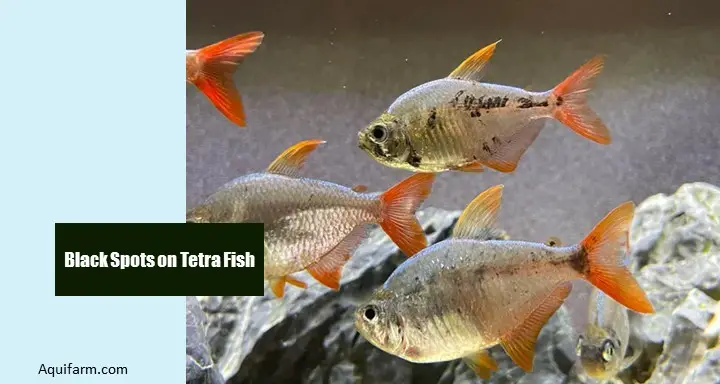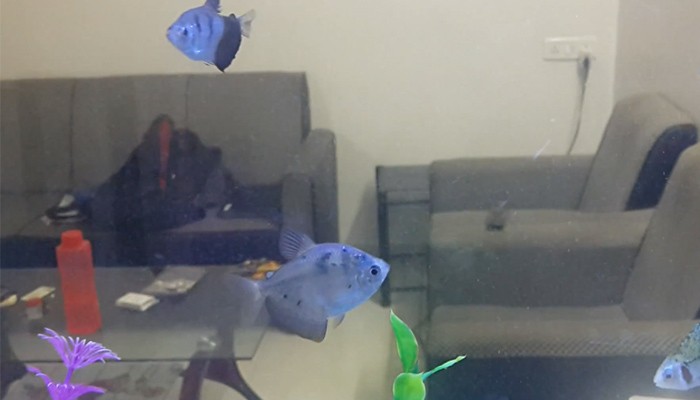
Tetra fish in aquariums are surely the best addition for their vibrant colors. But regrettably, these fish are highly susceptible to some disorders and diseases. Hence, one day you might find yourself asking why there are black spots on your tetra fish!
Well, many aquarists come with this problem and now it seems a common fish disease. But the black spots make the tetra fish look unsightly and surely nobody wants it to happen to their fish.
However, there could be many reasons for black spots on tetra fish but the main reason is the attack of a parasite. This parasitic infestation can take place in the tank water in many ways. Hence, when the attack occurs, the tetra fish must require treatment.
So, bear with us till the last to know the causes along with the solution to save your beautiful tetra fish.
Reasons for Black Spots on Tetra Fish

As we have already mentioned, the reason behind these spots on your tetra fish is the parasitic flatworms. These worms do not attack only the tetra fish. In fact, they can attack other surgeonfish as well.
This disease is also known as black ich or tang disease. However, different types of parasites can cause this disease. But in most cases, the black spots that are seen on the fish skin are named Turbellaria flatworms.
Fortunately, these flatworms are not deadly. They do not cause much harm to the tetra fish. But even though they are less dangerous yet these worms take place on the fish skin and create an unsightly view.
However, there are other types of protozoan parasites that also cause black spots on tetra fish. These parasites are harmful to the fish. In fact, they are life-threatening.
Nonetheless, care and treatment should be taken since they destroy the beautiful appearance of tetra fish and at a certain point also damage the health of your fish.
Moreover, once the worms manage to enter the tank they start to produce rapidly. And soon they spread throughout the entire tank and attack all its inhabitants. Thus, prompt treatment is required.
Favorable Weather for Black Spots on Tetra Fish
The disease mostly takes place in tropical and warm climates. Higher temperatures are favorable conditions for the worms to develop and attack the fish. However, the black spot disease can be found in temperate regions as well.
How the Parasites Attack Tetra Fish – Life Cycle

Parasites are supposed to live on hosts. It is a part of their lifecycle. Nothing is exceptional for these flatworms as well. They require a host too. Nonetheless, the process of parasitic attack occurs in a cycle. However, the cycle is a bit complex.
It all starts with a kingfisher also known as a fish-eating bird. Another name for the fish is the great blue heron. It eats a fish that was already infected. Hence, the worms or parasites are released in the intestine of the kingfisher and grow to their sexual maturity eventually.
Consequently, with the droppings of the bird, the mature worms pass their eggs into the tank water. The eggs in water hatch through the free-swimming organisms. Then the eggs find their way to the snails in the water for their further development.
After their development, the worms leave the snails and take place beneath the skin of your tetra fish and form cysts.
Later, the cysts are surrounded by black pigmentation that is formed by the kingfisher. Thus, you see the black spots and name them black spot disease. Again, when the kingfisher eats infected fish, the cycle repeats. This is how it goes on and on.
Some other Symptoms of Black Spot On Tetra Fish
Initially, you can detect black spots on the tetra fish. But there is more to inspect and diagnose. Moreover, it is important to be certain about the fact if it is actually an attack from parasites. The symptoms might help you with that. So, let’s see,
- Small, black, multifocal, and slightly raised lesions on the skin surface of tetra fish.
- You can find the black spots anywhere on the fish’s body including the flesh, skin, and fins of the fish.
- Scratching or rubbing against the tank or its décor
- Faded or dissolving color
- Growth retardation in tetra fish
- Reduced appetite
- Change of skin color. Skin becomes gray or pale in color
- Might develop red lesions as well on the skin
- Tetra fish face trouble while swimming
- Tetra fish isolate themselves from other organisms in the fish tank
These are some signs that you see in the early stage of the parasite attack. Since the disease spreads fast, your tetra fish might die within a few days of showing these symptoms.
Treatment for Black Spot on Tetra Fish
Once your tetra fish is affected with black spot disease there is no treatment that can remove the spots and cure the disease. It is because by then the black spots become active. However, controlling the disease might help you a bit.
So, you can treat the disease by taking up the following methods.
- To control the spread of the black spot disease on your tetra fish you can apply effective antifungals (our pick: API PIMAFIX Antifungal Freshwater and Saltwater Fish). The antifungal will provide protection against the disease and also prevent other fungal diseases.
- Since the disease does less harm to the fish but creates an unsightly view, skinning the infected part of tetra fish will help to remove the spots. However, skinning will also loss of the true color of fish.
- During the outbreak of the black spot disease, gravel vacuuming of the tank might help reduce encysted parasites or worms.
- Replace your tetra fish in a quarantined tank. It will not allow any further increase in the parasite population.
- Give your tetra fish a dip in freshwater after offering a formalin bath. Must follow the instructions while using the formalin product.
- Increasing water temperature also helps kill the worms in the water. Increase the temperature to 82 degrees Fahrenheit.
- Moreover, you can adopt another treatment that is named Praziquantel. This treatment method has shown a higher rate of success in treating fish with black spot disease in quarantine fish tanks.
- Also, adding salt to the tank water can kill the worms. It is another effective way. Salt makes the parasites dehydrated and stops the spread. However, it is better to use aquarium salt or table salt that is non-iodized.
Moreover, make the right concentration by taking one tablespoon of salt per one-gallon water. It should be a two-week treatment.
So, these are some probable treatments you can follow to stop or control the spread. In the case of pond water, many use copper sulfate or formaldehyde. Again, many use methylene blue as a medication.
However, you should also know that medications can turn out to be harmful to tetra fish. Therefore, you better go for the preventive measures.
Preventive Care of Black Spots on Tetra Fish
Go For Clean Water
Keep your precious tetra fish in clean water since it is the most important thing to prevent black spot disease. Your fish deserves to be in clean water. Clean water in a fish tank provides necessary oxygen to the fish and also helps in removing waste from its body.
Thus, it helps in retaining the better health conditions of tetra fish. Along with the black spot disease, it also helps in preventing bloating, fin rot, white spot, and other diseases. Whereas cloudy and polluted water leads to several bacterial infections.
Constant Water Temperature
Achieving constant water temperature can also prevent black spot disease. It also retains the healthy growth of tetras. Since tetras are tropical fish, they require temperatures between 70 to 80 degrees Fahrenheit in the aquarium.
These temperatures also prevent bloating disease ensuring proper digestion system. By keeping the water temperature constant at higher or lower ranges, you can solve many problems of your tetra fish.
Applying Hyposalinity
You can also apply this treatment if your tetras belong to fish-only tanks. Hyposalinity is basically an osmotic shock that is done by decreasing salt concentration in water. While applying this method, it is important to stir the substrate frequently.
It helps in releasing higher salinity concentrated water that is trapped in the gravel. It exposes the flatworms and releases them to the water with a lower salinity concentration.
Offer a Balanced Diet
A balanced diet is also important to prevent the tetras from black spot disease. A balanced diet is a key to disease-free tetras. There are several diets available in the market for the proper feeding of your tetras.
However, feeding a variety of foods is suggested by the aquarists to have tetras resistant to all diseases including black spots.
Again, make sure not to overfeed your tetras. Overfeeding can several digestion issues and your fish might get sick and be susceptible to any diseases.
Tank Maintenance
Frequent tank maintenance is important since anything wrong in the water can stress out the tetra fish in the aquarium. That is why you have to remove all ingredients that are stress-inducing. So, it is important to keep the water clean.
Moreover, tetra fish require a blackwater environment if they have to keep companionship with other fish. The water has to be well-filtered and also, well-oxygenated.
Therefore, monitoring tank conditions on a regular basis is important. Again, recommended ranges of pH level and other parameters should also be maintained.
Regular Inspection
Regular inspection for signs caused by any infections can also prevent the black spot on your tetra fish. Check if there are any signs of the presence of parasites or flatworms. If you find any signs take prompt treatment.
FAQs
What Are The Black Dots On My Tetra Fish?
Parasitic flatworms take place on the fish skin as small black spots. Thus, it is known as black spot disease. The disease does not have a specific cure yet you can prevent it by following our stated methods.
Why Is My Tetra Fish Turning Black?
There could be many reasons for your tetra fish turning black. Yet, stress may be the main reason. If your tetra fish got some bullies then it will stress out and eventually turn black.
How Do I Know If My Tetra Fish Is Dying?
Well, they will show some signs including acclimatization and stress, abnormal patterns of swimming, restlessness, and others. However, these are signs of a fungal or parasite attack. Nonetheless, know that prevention is better than cure.
Final Words
You surely enjoy watching your tetra fish swim around the tank. It is peaceful and mesmerizing till the moment you discover black spots on the side of their skin.
Now that you know why there is a black spot on your tetra fish along with the preventive measures and treatment hopefully, your fish won’t suffer from it.
However, once you inspect the disease you have to give extra care to your fish. Since the disease is very common frequent inspections will help in preventing it.
So, if our article has managed to save your tetra fish, leave us your feedback. Also, let us know if you have any queries.
- Top 15 Freshwater Aquarium Plant Ideas for a Lush, Green Tank - November 9, 2024
- Top 13 Freshwater Aquarium Layout Ideas for a Beautifully Organized Tank - November 9, 2024
- 14 Stunning Rustic Freshwater Aquarium Ideas for a Tranquil Environment - November 9, 2024
